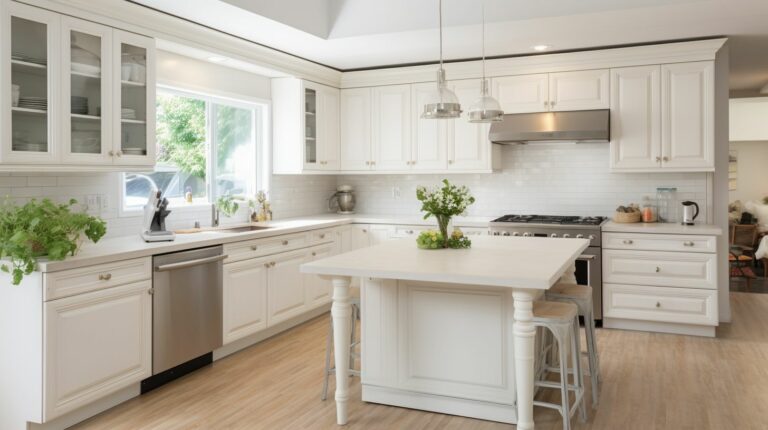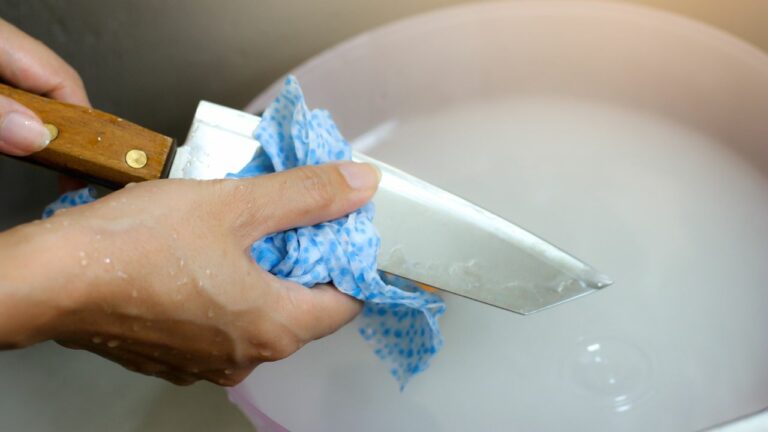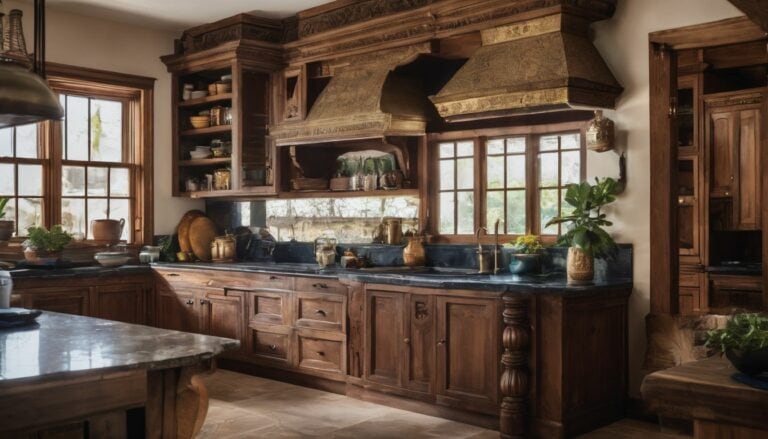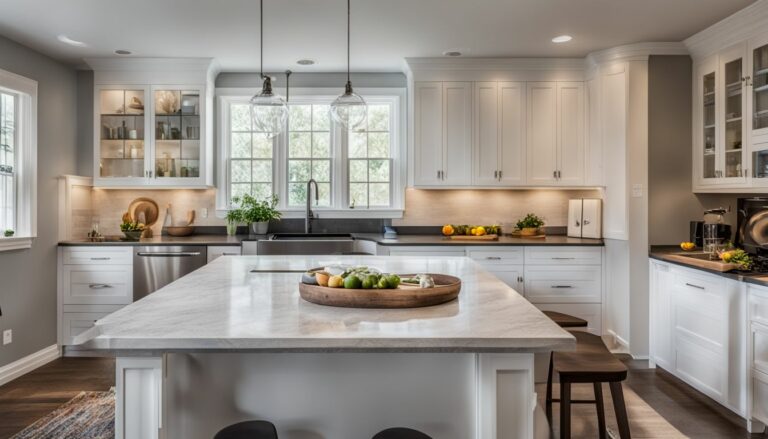How to Clean Sticky Wood Kitchen Cabinets: An Effective Guide for Removing Residue
Can’t seem to shake off that greasy, sticky residue haunting your kitchen cabinets? Trust me, I totally get you. After playing guinea pig with countless methods, I’ve come across solutions that are surefire winners against even the most stubborn grime.
This blog is dedicated to sharing those secrets using regular household items. Get ready to unlock the magic of spotless and gleaming kitchen cabinets!
Key Takeaways
- Cleaning sticky wood kitchen cabinets can be done using household items like dish soap, baking soda, white vinegar, and citrus cleaners.
- To remove grease and dirt from wooden cabinets, mix dish soap with warm water and gently scrub the cabinets with a soft cloth or sponge.
- For stubborn stains, create a paste of baking soda and warm water, apply it to the stains, scrub gently, and wipe away with a damp cloth.
- Alternative methods include using white vinegar mixed with hot water or citrus multipurpose cleaner to effectively remove sticky stains from wood kitchen cabinets.
Necessary Supplies for Cleaning
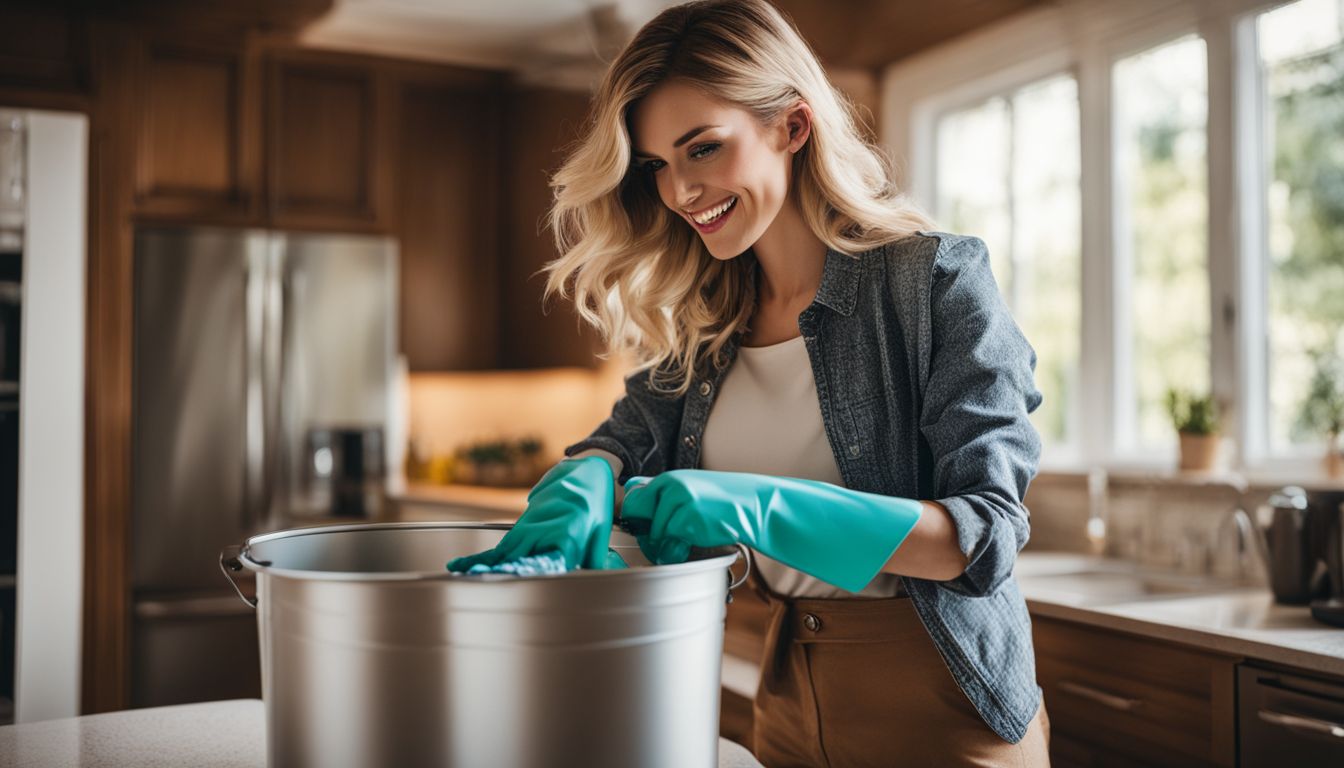
I always make sure to have the right supplies before I start cleaning. Having them handy can make the job go faster and smoother. Here’s what I use:
- Cleaning supplies: These include a bucket, warm water, a soft cloth or sponge.
- Kitchen cabinet cleaner: This helps to remove the dirt and grime from kitchen cabinets.
- Wood cleaner: This product is used for cleaning wood surfaces without damaging them.
- Grease remover: This gets rid of hard-to-remove grease stains.
- Grime remover: This solution removes stubborn grime stuck on your cabinets.
- Diluted vinegar: A 50/50 mix of vinegar and warm water works perfect for wiping away grease.
- Wood finish protection: Use this to protect your cabinets after you clean them.
- Cleaning solution: Either buy a commercial kitchen cabinet cleaner or make one with vinegar and warm water.
- Greasy cabinet cleaner: You may need this if your cabinets are really greasy.
- Sticky cabinet cleaner: If you have sticky spots, then this is what you need.
How to Remove Grease and Dirt from Wooden Cabinets
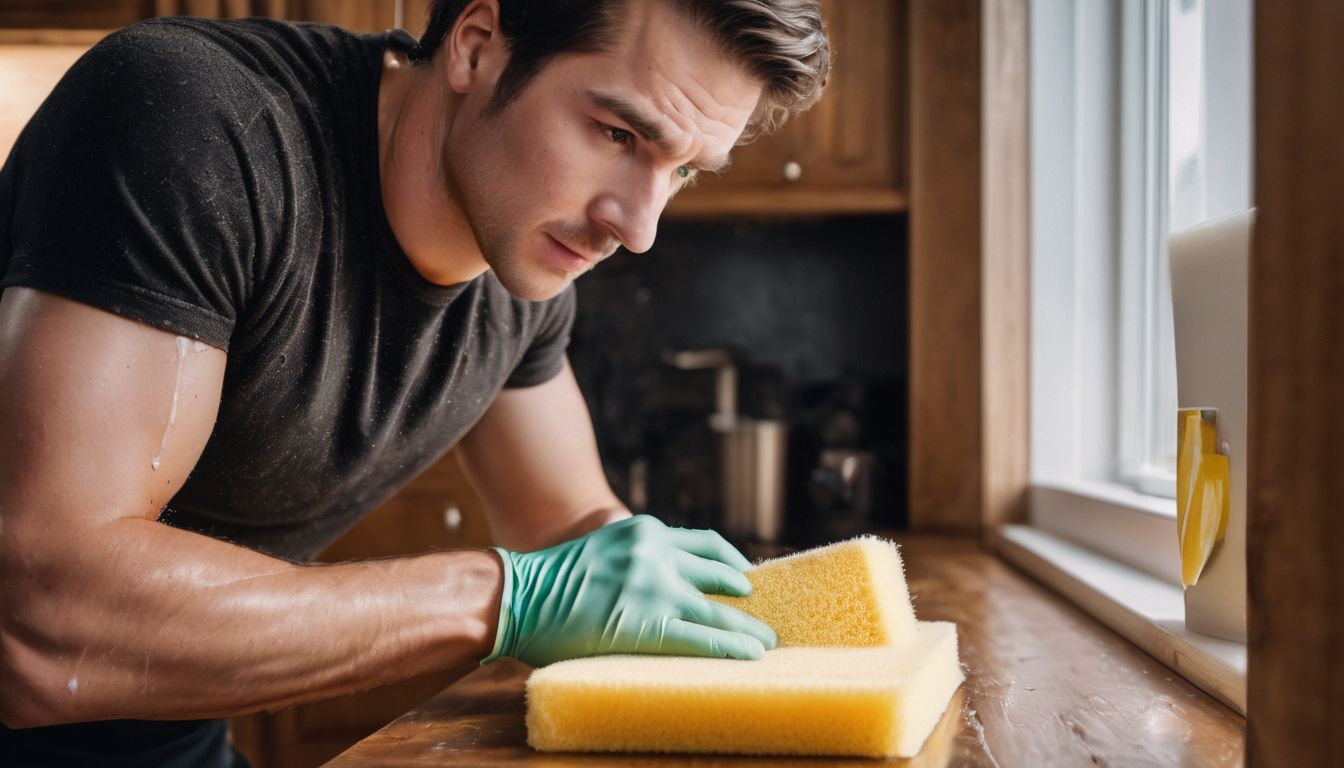
To remove grease and dirt from wooden cabinets, start by using dish soap. Mix a few drops of blue Dawn dishwashing soap with warm water in a bucket or sink. Dip a sponge or microfiber cloth into the soapy mixture and wring out any excess liquid.
Gently scrub the greasy areas of the cabinets, applying even pressure to lift away the grease and dirt. Rinse the sponge or cloth frequently in clean water to prevent spreading the grime around.
Finally, dry the cabinets thoroughly with a clean, dry cloth to avoid leaving any streaks or water spots on the wood surface.
Using dish soap

I always care about the wood in my home, especially kitchen cabinets. Using dish soap comes in handy when it’s time to cut through grease and dirt. Here is how I do it:
- Grab a big bowl.
- Fill it with warm water.
- Add a few spoonfuls of Dawn® dish soap into the water.
- Stir the mix until bubbles form.
- Dunk a soft cloth into the soapy water.
- Wring out excess water from the cloth and start scrubbing the cabinets gently.
Baking soda method

Cleaning sticky grease stains off wooden cabinets can be a chore. But, I found baking soda to be a natural and cost-friendly tool in this task. Here’s how to do it:
- Make a mix of baking soda and warm water – It should feel like paste.
- Put on gloves – It helps protect your hands.
- Apply the mix on the grease stains – Use a soft cloth or sponge.
- Scrub gently – Be careful not to scratch the wood.
- Wipe off the mix with a damp cloth – Do this until all the baking soda is gone.
- Dry off the surface – Use a dry towel.
Alternative Methods for Cleaning Sticky Stains
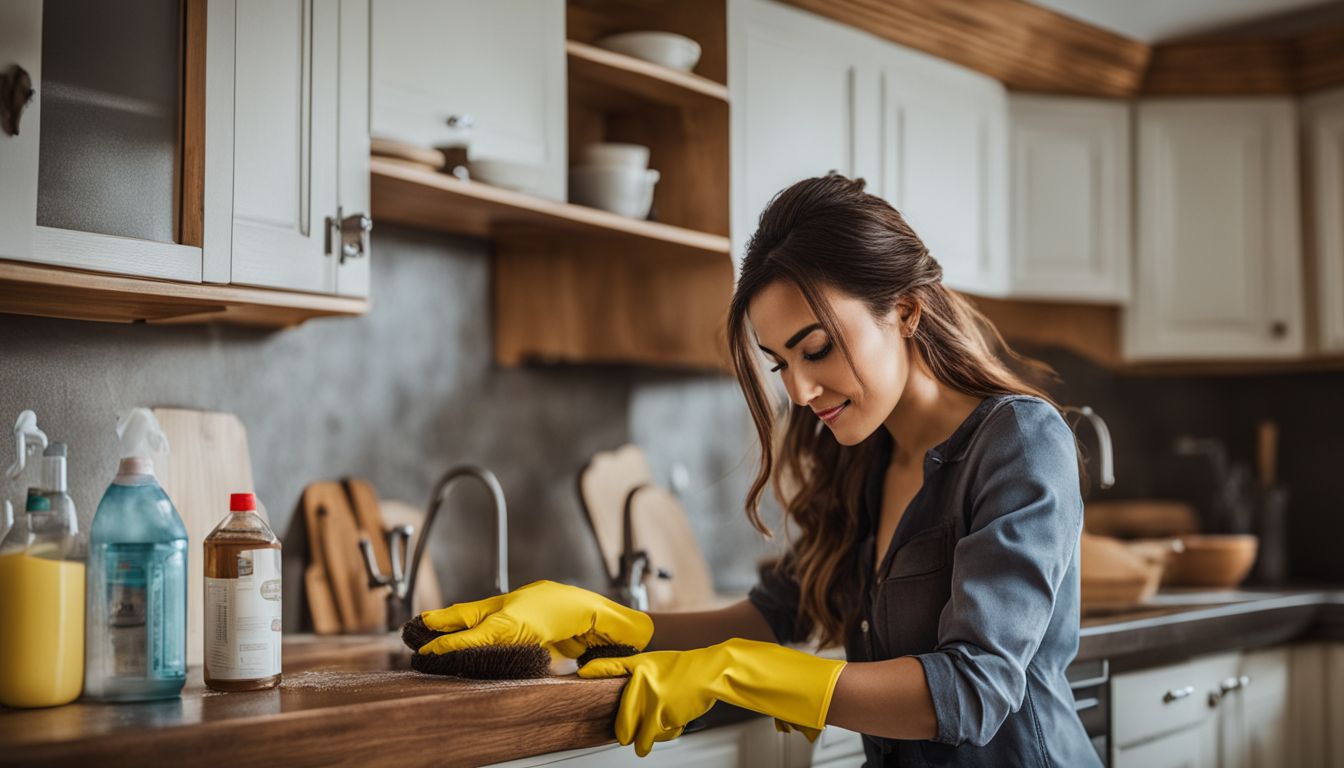
In addition to using dish soap and baking soda, there are several alternative methods that can effectively clean sticky stains on wood kitchen cabinets.
White vinegar and hot water
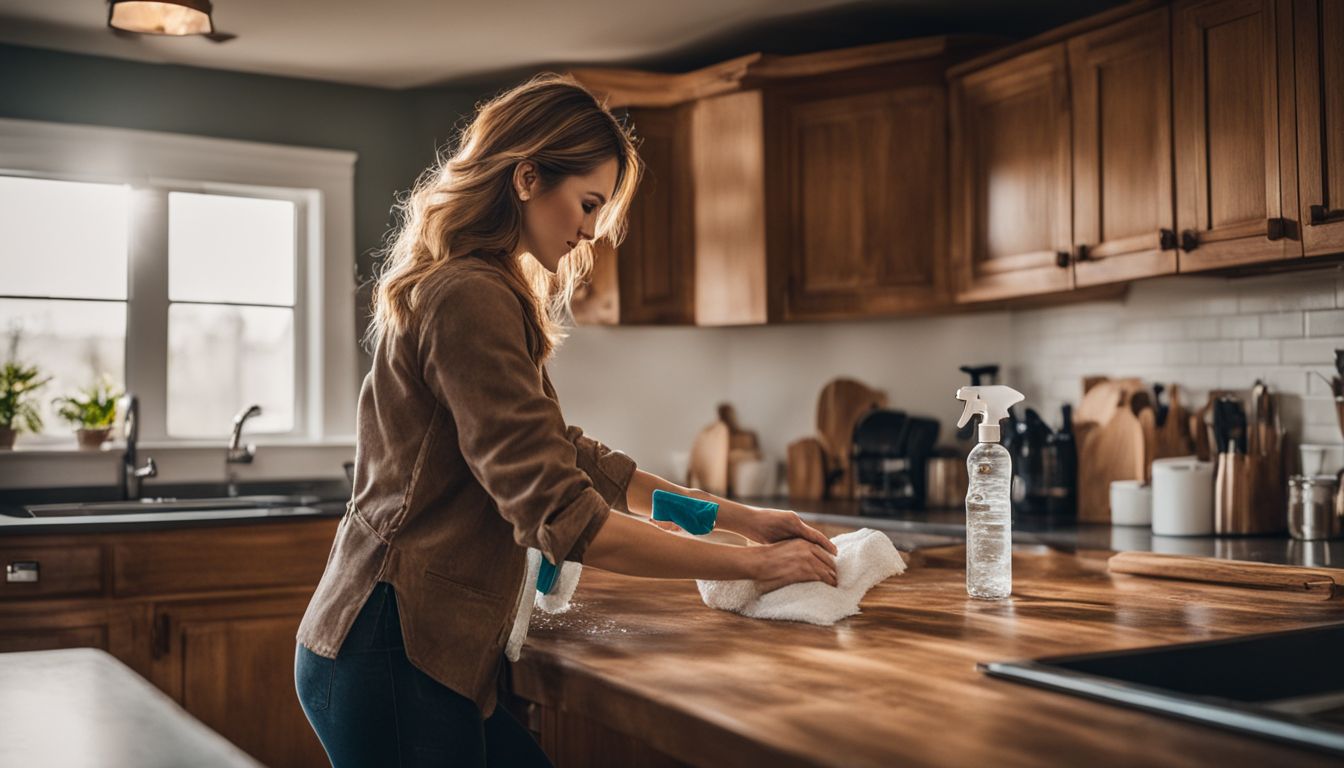
White vinegar and hot water are effective alternative methods for cleaning sticky stains on wood kitchen cabinets. Vinegar is a natural cleaner with excellent degreasing properties, making it effective for removing sticky grease from kitchen cabinets. To clean wood cabinets, mix a 50/50 solution of vinegar and warm water and spray it onto the cabinets. Use a clean cloth or sponge to wipe the cabinets, preferably a lint-free cloth.
Citrus multipurpose cleaner

Citrus multipurpose cleaner is a great option for cleaning sticky stains on kitchen cabinets. It contains natural degreasing agents that effectively remove grease and grime. Here are some ways you can use citrus multipurpose cleaner to clean your cabinets:
- Spray the citrus multipurpose cleaner directly onto the sticky areas of your cabinets.
- Let the cleaner sit for a few minutes to allow it to penetrate and break down the sticky residue.
- Use a sponge or cloth to wipe away the cleaner and the residue.
- Repeat as necessary until the sticky stains are completely gone.
Baking soda and lemon

Baking soda and lemon are a great combination for cleaning sticky stains on kitchen cabinets. Here’s how you can use them:
- Mix baking soda with water to create a paste.
- Squeeze some lemon juice into the paste and mix it well.
- Apply the mixture onto the sticky stains on your cabinets.
- Let it sit for a few minutes.
- Scrub the stains gently with a soft cloth or sponge.
- Wipe away the residue with a clean cloth.
Aftercare for Kitchen Cabinets
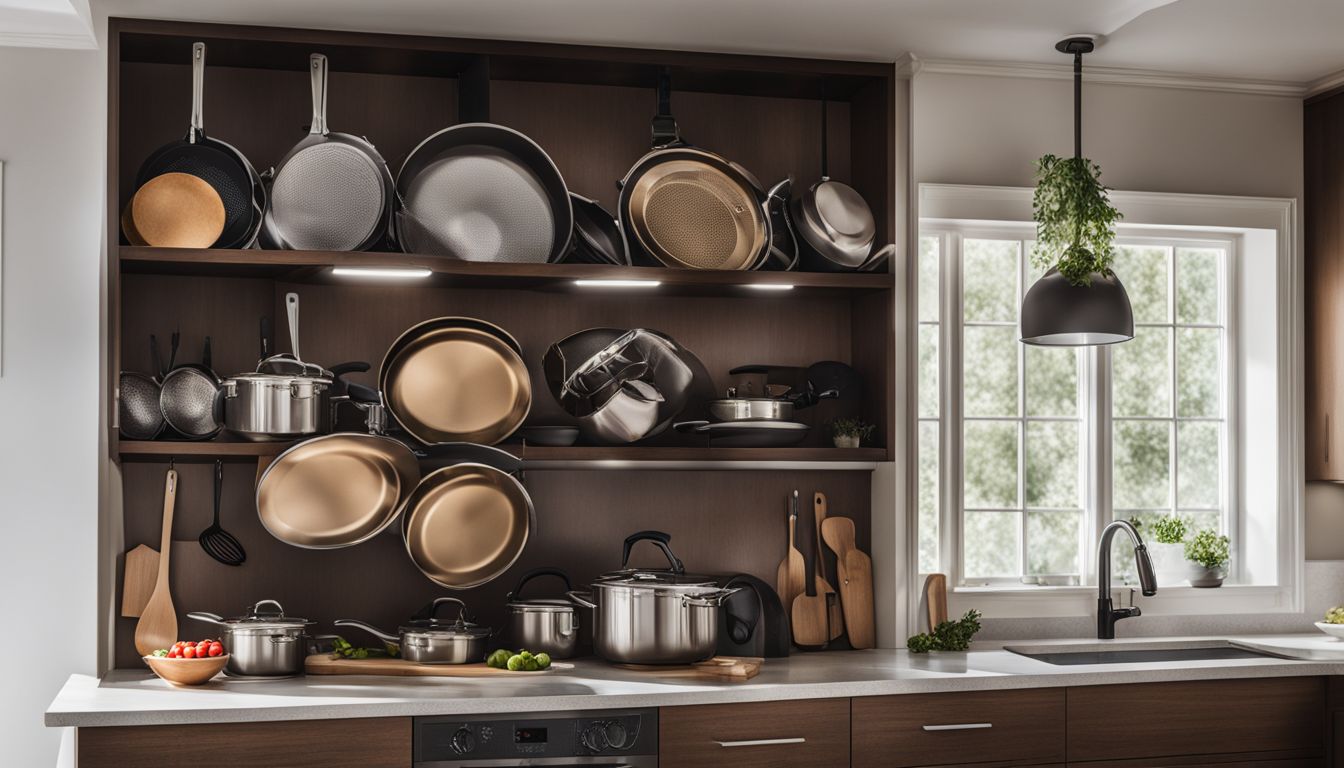
Preventing grease build-up and maintaining the cleanliness of your kitchen cabinets is essential for their longevity. Discover simple tips and tricks to keep your cabinets looking brand new in our comprehensive guide!
Preventing grease build-up
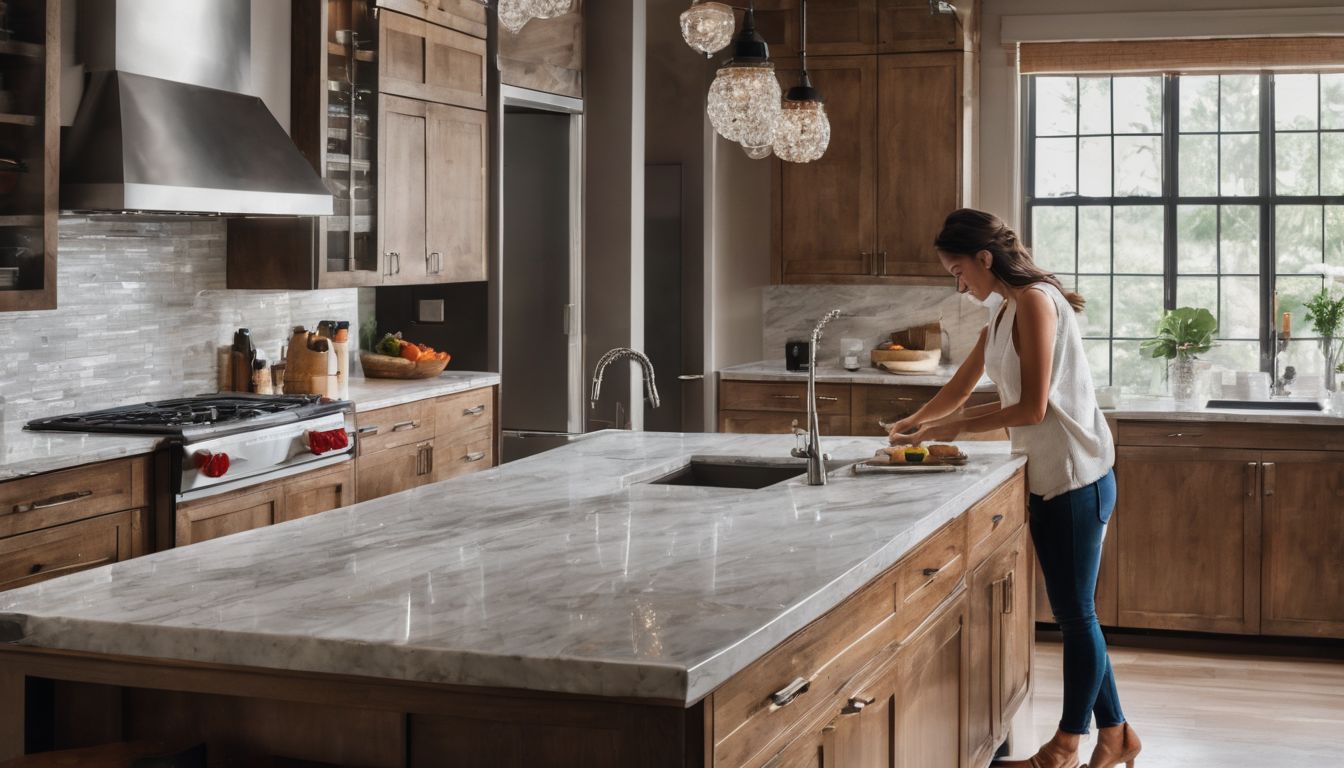
To prevent grease build-up on your kitchen cabinets, it’s important to take regular care of them. Grease accumulation can make cabinets sticky and difficult to clean. One way to prevent this is by wiping down the cabinets regularly with a solution of warm water and dishwashing liquid.
This helps to remove any surface grease before it has a chance to build up. Another tip is to avoid cooking with excessive amounts of oil or using greasy utensils near the cabinets.
By being mindful of these things and maintaining a consistent cleaning routine, you can keep your kitchen cabinets looking fresh and free from stubborn grease stains.
Regular cleaning routine

Cleaning your kitchen cabinets regularly is essential for maintaining their appearance and ensuring they last a long time. Here are some tips to help you establish a regular cleaning routine:
- Wipe down your cabinets once a week with a soft cloth or sponge. This will remove any surface dirt, dust, or fingerprints.
- Use a mild dish soap mixed with warm water to clean off grease and grime. Gently scrub the cabinet surfaces with the soapy solution using a non-abrasive sponge or cloth.
- Avoid using harsh or abrasive cleaners, as they can damage the finish of your cabinets.
- For stubborn stains or sticky residue, sprinkle some baking soda on a damp cloth and gently scrub the affected area. Rinse with clean water and dry thoroughly.
- After cleaning, make sure to wipe down your cabinets with a dry cloth to remove any excess moisture and prevent water spots.
How to Clean Cabinet Exteriors

To clean the exteriors of your kitchen cabinets, choose a suitable cleaner and use proper cleaning techniques to restore their shine and remove any sticky residue. Don’t miss this important step in keeping your cabinets looking pristine!
Choosing the right cleaner
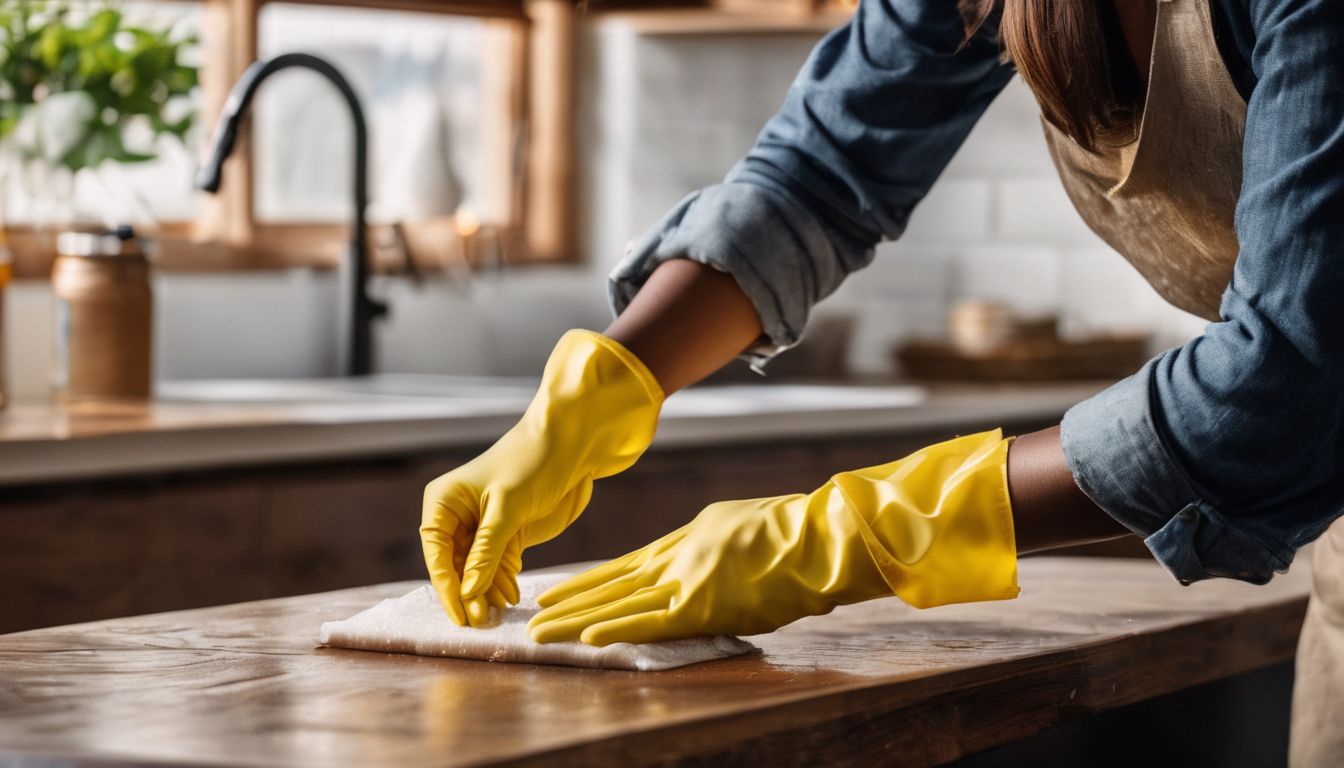
When it comes to choosing the right cleaner for your wood kitchen cabinets, there are a few things to keep in mind. Firstly, opt for an oil-based soap or cleaner that is specifically designed for use on wood surfaces.
These types of cleaners are gentle enough not to damage the wood but still effective at removing light or stubborn stains and residue. Additionally, look out for natural cleaning solutions that contain ingredients like citrus oil, as they can help break down grease and oil stains on your cabinets.
Remember, always follow the manufacturer’s instructions when using any cleaning product on your cabinets to ensure the best results.
Proper cleaning technique
To clean wooden kitchen cabinets properly, follow these steps:
- Start by removing any dust and grime from the cabinets using a soft microfiber cloth.
- Mix a cleaning solution using a mild dish soap and warm water.
- Dip a clean cloth or sponge into the mixture and wring it out to remove excess liquid.
- Wipe the cabinets in a gentle, circular motion, starting from the top and working your way down.
- For tough messes, spray the cleaning solution directly onto the surface of empty cabinets.
- Rinse the cloth or sponge frequently to avoid spreading dirt around.
- Dry the cabinets with a clean towel or let them air dry.
How to Clean Cabinet Interiors
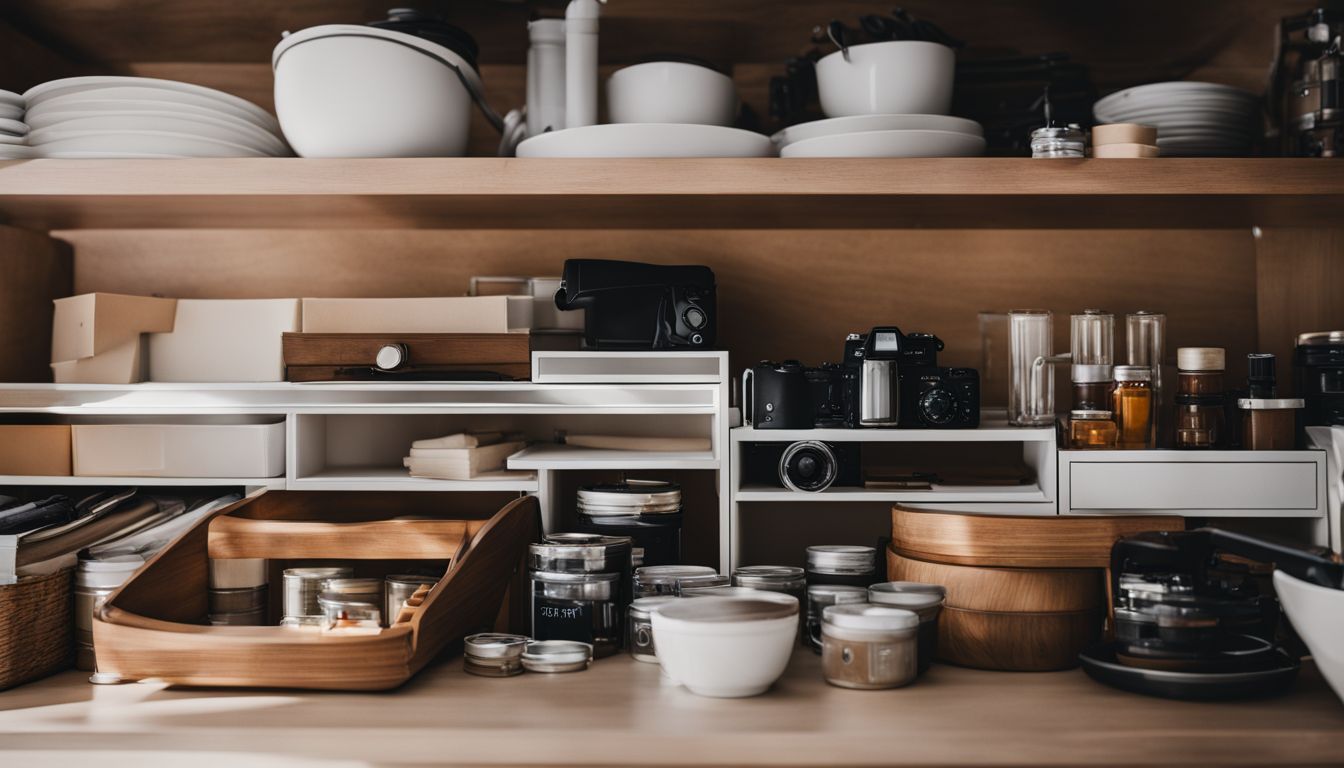
Remove all items from the cabinets and organize them before wiping down shelves and drawers with a mild cleaning solution. Discover the best techniques for keeping your cabinet interiors clean and tidy.
Removing items and organizing
To clean the insides of your kitchen cabinets, it’s important to remove all the items inside and organize them. Here are some tips for clearing clutter and tidying up:
- Take everything out of the cabinets and sort them into categories. This will make it easier to put things back in an organized way.
- Dust off any loose dirt or debris from the shelves and drawers using a lint – free cloth.
- Wipe down the surfaces with a damp cloth or mild cleaning solution to eliminate dirt and grime.
- Before putting everything back, consider decluttering and getting rid of any items you no longer use or need.
- When arranging the items back into the cabinets, place them in a logical order based on frequency of use or category.
Wiping down shelves and drawers
To keep your cabinet interiors clean and organized, it’s important to regularly wipe down the shelves and drawers. Here are some simple steps to follow:
- Remove all items from the shelves and drawers. This will make it easier to clean and ensure that you don’t miss any spots.
- Use a damp cloth or sponge to wipe down the surfaces of the shelves and drawers. Make sure to remove any crumbs, spills, or sticky residue.
- For stubborn stains or grease marks, you can use a mixture of warm water and mild dish soap. Dip your cloth or sponge into the soapy water, then gently scrub the affected areas.
- Rinse your cloth or sponge with clean water and wring out any excess moisture before wiping down the shelves and drawers again. This will help remove any remaining soap residue.
- Finally, dry the surfaces thoroughly with a clean towel or allow them to air dry before placing items back into the cabinets.
Dealing with Stubborn Stains
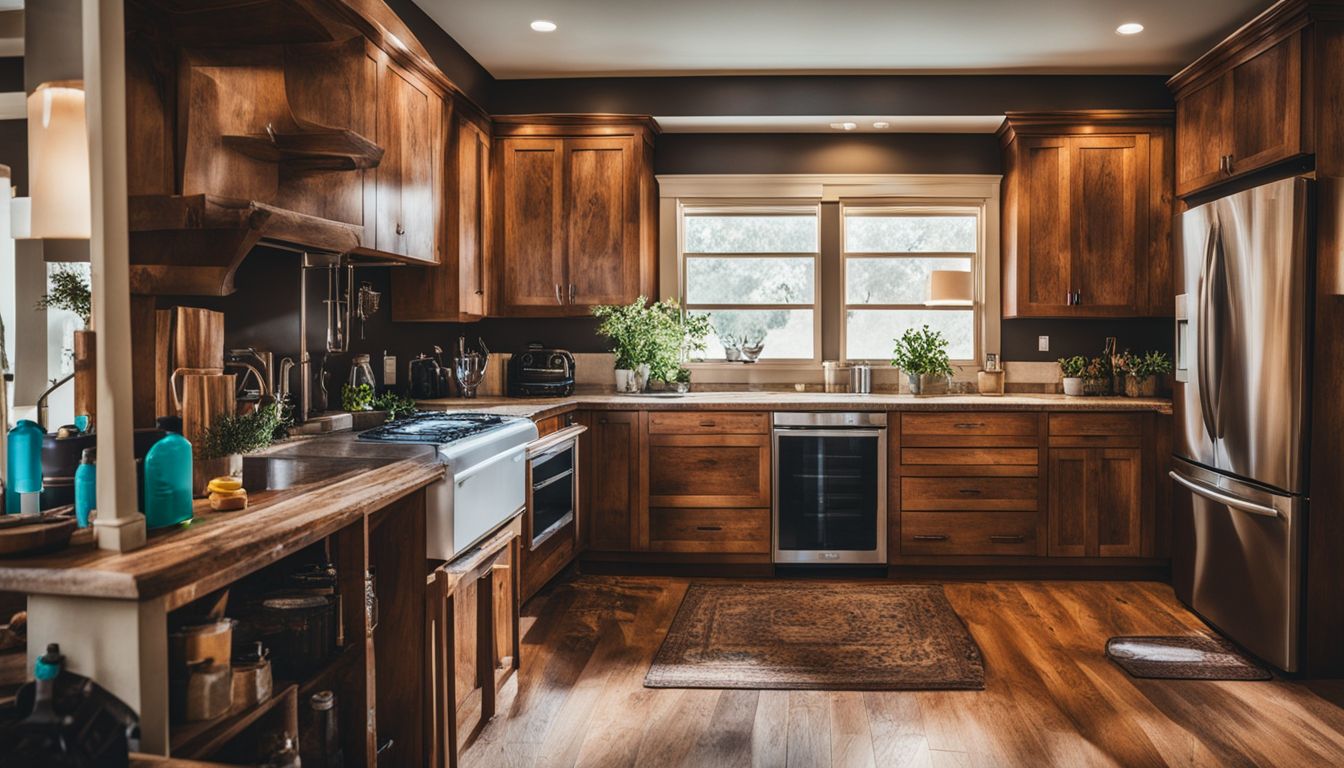
If you’re struggling to remove stubborn stains from your wood kitchen cabinets, don’t worry! I have some effective solutions that will help you tackle even the toughest residue. Keep reading to find out more.
Using natural orange oil
I love using natural orange oil to clean my sticky wood kitchen cabinets. It’s a powerful degreaser that can effectively remove residue and stains. Here’s how I use it:
- Apply undiluted orange oil directly onto the sticky areas of the cabinets.
- Let it sit for a few minutes to penetrate the grease and grime.
- Use a soft cloth or sponge to wipe away the orange oil and the sticky residue.
- For tougher stains, you can mix orange oil with water, vinegar, or baking soda to create a cleaning solution.
Howard Orange Oil products
I love using Howard Orange Oil products to clean and polish wood surfaces. They work great on kitchen cabinets, tables, chairs, desks, paneling, and antiques. These products can easily remove sticky areas and greasy stains on wood kitchen cabinets.
The best part is that they don’t dry out the wood finish like some other cleaners do. Many people trust Howard Orange Oil for cleaning and polishing their wood surfaces because it’s effective and safe to use.
Howard Products Complete Wood Restoration Kit
The Howard Products Complete Wood Restoration Kit is a comprehensive solution for cleaning, protecting, and restoring wood finishes. It includes Restor-A-Finish, which can penetrate and permanently restore most wood finishes without removing the existing finish.
The kit also includes Clean-A-Finish, which quickly removes dust, dirt, grime, and other stains from finished and unfinished wood surfaces. This kit is perfect for use on kitchen cabinets, wood furniture, and other wood finishes.
With the Howard Products Complete Wood Restoration Kit, you can effectively remove stubborn stains and residue from your sticky wood kitchen cabinets.
Store-Bought Solutions
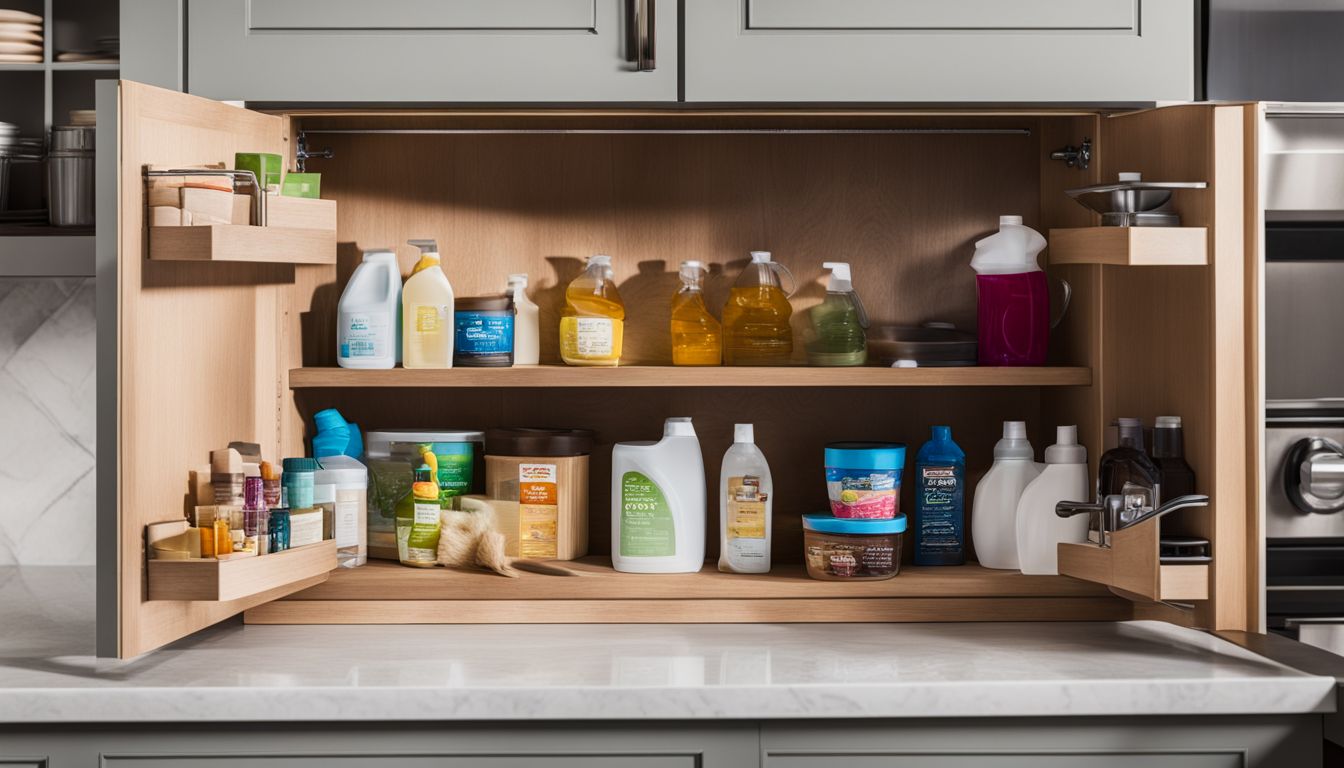
You can also explore store-bought solutions for cleaning sticky wood kitchen cabinets. There are general wood cabinet cleaners available that can effectively remove residue and grease.
For heavier build-up, you may want to consider using a heavy-duty wood cabinet cleaner specifically formulated for tough stains and grime.
General Wood Cabinet Cleaner
I prefer to use a general wood cabinet cleaner when it comes to cleaning my kitchen cabinets. This type of cleaner is easy to make at home using ingredients like olive oil, white vinegar, Blue Dawn dish soap, and warm water.
The combination of these ingredients creates an effective solution that can remove years of grit and grime from the cabinets. I find that dish soap works well as a wood cabinet cleaner because it’s strong enough to remove grease but gentle on the wood finish.
Another trusted option is a 50/50 mixture of water and vinegar, which can also be used as an effective cabinet cleaner. Overall, using a general wood cabinet cleaner helps me keep my cabinets clean and looking their best without causing any damage.
Heavy-duty wood cabinet cleaner
One great solution for tackling stubborn stains on wood kitchen cabinets is a heavy-duty wood cabinet cleaner. This type of cleaner is specifically designed to cut through tough grease and grime, making it perfect for sticky residue.
It usually comes in a spray or liquid form, allowing you to easily apply it to the affected areas. Simply follow the instructions on the label, using a soft cloth or sponge to gently scrub away the sticky mess.
The powerful formula of this cleaner will help restore your cabinets to their original shine and leave them looking clean and fresh.
Conclusion
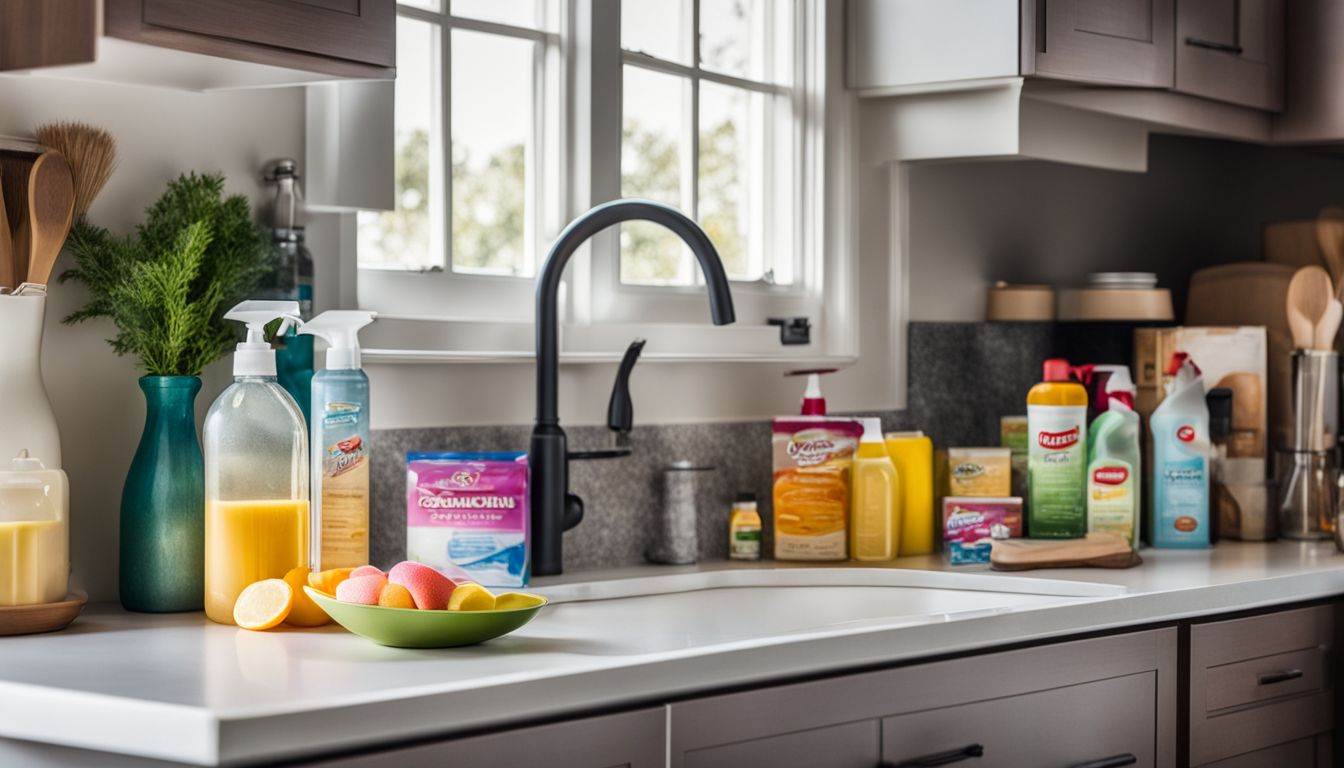
Cleaning sticky wood kitchen cabinets and removing residue can be easily achieved using simple household items. By following the methods outlined in this guide, such as using dish soap or a baking soda solution, you can effectively remove grease and dirt from your cabinets.
Additionally, natural alternatives like white vinegar and citrus cleaners work wonders for tackling stubborn stains. Remember to establish a regular cleaning routine to prevent build-up and keep your cabinets looking shiny and fresh.
With these tips and techniques, you’ll have clean and residue-free kitchen cabinets in no time!
FAQs
What causes sticky residue on wood kitchen cabinets?
Sticky residue on wood kitchen cabinets can be caused by grease, food spills, or cleaning products that weren’t properly wiped off.
How do I clean sticky wood kitchen cabinets?
To clean sticky wood kitchen cabinets, mix a solution of warm water and mild dish soap. Use a soft cloth or sponge to gently scrub the surface, then rinse with clean water and dry with a towel.
Can I use vinegar to clean sticky wood kitchen cabinets?
Yes, you can use a mixture of equal parts vinegar and water as an alternative cleaning solution for sticky wood kitchen cabinets. Test it on a small hidden area first to ensure compatibility.
Should I use abrasive cleaners or tools to remove the stickiness from my wooden cabinets?
No, avoid using abrasive cleaners or tools like steel wool that can damage the finish of your wooden cabinets. Stick to gentle methods mentioned earlier for effective cleaning.
How often should I clean my wood kitchen cabinets?
It’s recommended to regularly wipe down your wood kitchen cabinets with a damp cloth after cooking or whenever they appear dirty or sticky to maintain their cleanliness and prevent buildup over time.


